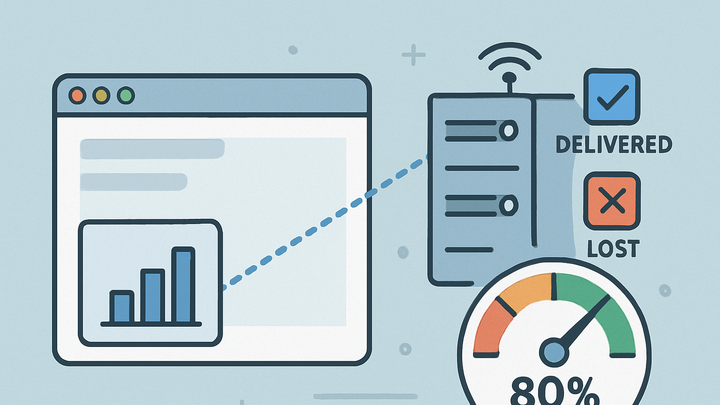Published on 2025-06-28T08:12:13Z
What is Delivery Rate? Examples for Delivery Rate
Delivery Rate in web analytics refers to the percentage of tracking events (also called ‘beacons’ or hits) that are successfully received and processed by your analytics server compared to those sent from the user’s browser or device. This metric helps you understand data loss caused by factors such as ad blockers, network failures, or script errors. A high delivery rate (typically above 95%) indicates reliable data collection and accurate reporting. Conversely, a low delivery rate can skew critical metrics like pageviews, sessions, and conversion rates, leading to misguided business decisions. Monitoring delivery rate allows you to identify implementation issues, optimize site performance, and maintain compliance with industry reporting standards.
Delivery rate
Delivery Rate measures the percentage of analytics events received by your server versus those sent from users’ browsers.
Why Delivery Rate Matters
Delivery Rate directly impacts the reliability of your analytics data. Missing or lost hits lead to undercounted user interactions and distorted KPIs, which can misguide product, marketing, and engineering teams. A stable, high delivery rate ensures that dashboards, reports, and automated alerts are based on complete datasets. In regulated industries, maintaining a strong delivery rate is also important for audit trails and compliance.
-
Data accuracy
An accurate delivery rate ensures you count nearly all user interactions. A low rate means missing data, which biases metrics like pageviews, sessions, and conversions toward users less affected by blockers.
-
Performance optimization
Monitoring delivery rate can highlight performance bottlenecks. If your analytics requests fail due to slow scripts or timeouts, you can optimize loading strategies to improve delivery.
-
Compliance and auditing
High delivery rates are often required for compliance audits. Industries with strict reporting standards (e.g., finance, healthcare) need near-complete data capture to meet regulations.
How to Measure Delivery Rate
Measuring Delivery Rate involves comparing the number of analytics beacons the browser sends with the number your analytics server processes. This helps identify data loss due to ad blockers, network errors, or script failures.
-
Count sent hits
Use browser developer tools or client-side logging to count the total number of analytics requests made by the page.
-
Count received hits
Check your analytics platform dashboard or raw log files to see how many beacons were successfully processed by the server.
-
Calculate delivery rate
Delivery Rate = (Received Hits / Sent Hits) × 100. A rate above 95% is generally considered good but can vary based on network conditions and user settings.
Example: Tracking with plainSignal
plainSignal is a privacy-focused, cookie-free analytics tool. You can implement it with a simple script tag and monitor your delivery rate via network logs or your plainSignal dashboard.
-
Insert PlainSignal script
Add the following to your HTML
<head>to start tracking:<link rel="preconnect" href="//eu.plainsignal.com/" crossorigin /> <script defer data-do="yourwebsitedomain.com" data-id="0GQV1xmtzQQ" data-api="//eu.plainsignal.com" src="//cdn.plainsignal.com/plainsignal-min.js"></script> -
Monitor network requests
Open your browser’s dev tools (Network tab) and filter requests to
eu.plainsignal.com. Compare the count of GET requests sent to those received in your plainSignal dashboard to estimate delivery rate. -
Review PlainSignal dashboard
plainSignal shows total hits and unique events. Use these metrics to calculate the percentage of hits processed versus sent over a given timeframe.
Example: Measuring Delivery Rate in GA4
While GA4 doesn’t expose a direct Delivery Rate metric, you can approximate it by comparing sent hits with received events in real-time reports and BigQuery exports.
-
Use debugview
Enable DebugView in GA4 to see incoming events in real time. Simultaneously, log hits on the client (e.g., with browser dev tools) to compare counts.
-
Export to bigquery
If you have BigQuery integration, export GA4 events and run SQL queries to count total events. Compare this with client-side logs for a delivery estimate.
-
Analyze measurement protocol requests
For server-side hits, review your Measurement Protocol implementation logs to ensure all payloads are delivered to GA4 when sent.
Best Practices to Improve Delivery Rate
Improving delivery rate involves optimizing your analytics implementation, reducing request failures, and implementing fallback mechanisms.
-
Load scripts asynchronously
Ensure analytics scripts don’t block page load and time out, improving chances of request delivery on slow connections.
-
Implement retry logic
Retry failed requests (e.g., exponential backoff) to recover from transient network errors.
-
Use server-side tagging
Shift analytics collection to a server endpoint to bypass some ad blockers and ensure higher delivery rates.
-
Minimize payload size
Smaller request payloads are less likely to be truncated or dropped by networks with strict limits.
-
Monitor and alert
Set up alerts when delivery rate falls below a threshold (e.g., 90%) to proactively address data loss issues.
